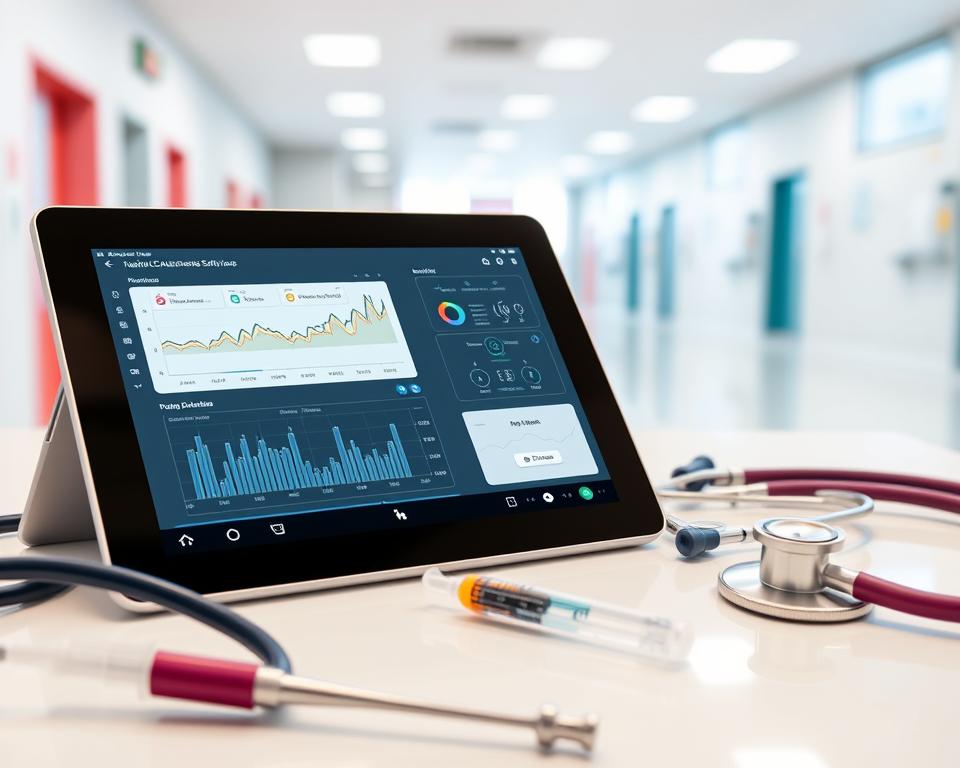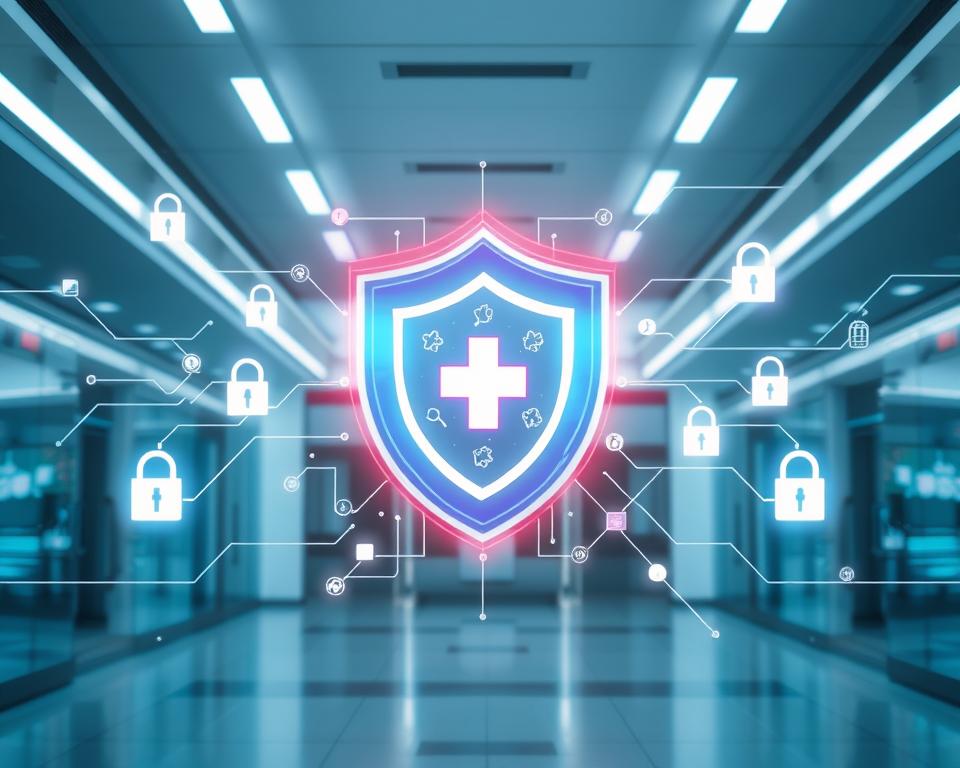The healthcare industry is quickly adopting SaaS solutions to make operations smoother and care better. These software solutions bring many benefits, like more efficiency and lower costs. This guide will dive into SaaS for healthcare, covering its basics, advantages, and uses.
Healthcare organizations can get better technology and expertise with SaaS solutions. This helps them offer better care and services to patients. SaaS in healthcare is getting more popular, and it’s key to know its current state and benefits.
Table of Contents
Introduction to SaaS for Healthcare
SaaS solutions are made for the healthcare industry’s unique needs. They offer features and functions for clinical, administrative, and financial operations. From electronic health records to practice management systems, SaaS solutions help improve patient outcomes and cut costs.
Key Takeaways
- Healthcare software, such as SaaS solutions, offers increased efficiency and reduced costs
- SaaS solutions provide access to advanced technology and expertise
- Healthcare organizations can improve patient care and services with SaaS solutions
- SaaS solutions support clinical, administrative, and financial operations
- Electronic health records and practice management systems are examples of SaaS solutions in healthcare
- SaaS solutions can help healthcare organizations improve patient outcomes and reduce costs
Understanding Healthcare SaaS Fundamentals
Healthcare technology has changed how healthcare groups work. SaaS basics are key in this change. They help make healthcare more efficient and affordable.
The mix of healthcare technology and SaaS basics helps healthcare groups work better. They can care for patients better and manage data well. Key parts of healthcare SaaS are:
- Scalability and flexibility to meet the evolving needs of healthcare organizations
- Secure and compliant data management to protect sensitive patient information
- Cost-effective solutions to reduce operational costs and improve resource allocation
As healthcare tech keeps growing, SaaS basics will become even more important. Knowing these basics helps healthcare groups choose the right SaaS solutions. This improves their work overall.
The Current State of SaaS for Healthcare
The healthcare industry is changing fast, thanks to new tech and what patients want. Now, more healthcare groups are using SaaS (Software as a Service). They prefer cloud-based solutions because they’re easy to use and update.
Some big trends in SaaS for healthcare are:
- Artificial intelligence and machine learning are making patient care better and workflows smoother.
- Cloud-based electronic health records (EHRs) and telemedicine platforms are becoming more popular.
- There’s a big push for patient engagement and personalized medicine.
As healthcare keeps changing, SaaS will keep getting better. We’ll see more digital solutions. This will lead to better patient care and more efficient healthcare.
| Trend | Description |
|---|---|
| Cloud-based EHRs | Secure, scalable, and accessible electronic health records |
| Telemedicine platforms | Remote patient consultations and virtual care services |
| Patient engagement tools | Personalized patient portals and mobile apps for enhanced care coordination |
Essential Benefits of Healthcare SaaS Solutions
Healthcare SaaS solutions bring many benefits to healthcare groups. They help with cost efficiency and resource optimization. This means healthcare providers can work better, spend less, and help patients more.
Some main benefits of healthcare SaaS solutions are:
- Improved scalability and flexibility
- Enhanced patient care delivery
- Increased efficiency and productivity
Using healthcare SaaS solutions helps organizations use their resources better. They can cut down on waste and save money. This lets them focus more on patient care and better health results.
Also, healthcare SaaS solutions offer tools like data analytics and workflow automation. These tools help healthcare providers make better choices, cut down on mistakes, and improve care for patients.
Common Healthcare SaaS Applications
Healthcare groups are now using healthcare applications to make their work easier and care better. They find SaaS platforms very helpful. These platforms save money, grow with needs, and are flexible.
Some common healthcare applications of SaaS platforms include:
- Electronic health records (EHRs)
- Practice management systems
- Telemedicine platforms
These healthcare applications help manage patient data, book appointments, and offer remote care. Using SaaS platforms, healthcare groups can cut costs, work better, and care for patients more.
The healthcare world is changing fast. So, the use of healthcare applications and SaaS platforms will grow. This will lead to new ideas and better care for patients.
Security and Compliance in Healthcare SaaS
Healthcare SaaS providers must focus on security and compliance to protect patient data. The Health Insurance Portability and Accountability Act (HIPAA) is the key standard for compliance in healthcare. To keep data safe, healthcare SaaS providers need to use strong security measures.
Some important steps for security and compliance include:
- Using encryption to keep data safe while it’s being moved and stored
- Setting up access controls to limit who can see patient data
- Keeping audit trails to track who accesses and changes patient data
Healthcare SaaS providers must also follow HIPAA compliance rules. This means keeping patient data safe and getting the right consent before sharing it.
By focusing on security and compliance, healthcare SaaS providers can build trust with their patients. They also avoid big fines and penalties for not following the rules.
| Measure | Description |
|---|---|
| Encryption | Protects data in transit and at rest |
| Access Controls | Restricts unauthorized access to patient data |
| Audit Trails | Tracks all access and changes to patient data |
Implementation Strategies for Healthcare Organizations
Implementing healthcare SaaS solutions starts with a detailed assessment and planning phase. It’s important to check the current setup, find what needs work, and plan the best way to implement. A good plan helps everything go smoothly and keeps patient care on track.
When it comes to implementation, integrating with current systems is key. Healthcare groups need to make sure their SaaS fits well with EHRs, practice management systems, and other important tools. This means careful planning and teamwork to avoid data problems and ensure everything works together.
Good assessment and planning also mean thinking about staff training. Healthcare teams need to learn how to use the new SaaS well. This includes learning about the system, how to enter data, and how to fix problems. With the right training, teams can use the SaaS to its fullest potential.
Some important things to think about when adding SaaS solutions include:
- Doing a full assessment of what you already have
- Creating a detailed planning strategy for implementation
- Making sure it works well with what you already use
- Offering thorough training and support for staff
Key Features of Modern Healthcare SaaS Platforms
Modern healthcare SaaS platforms have key features that help healthcare organizations give top-notch care. They also make operations more efficient. These features include cloud-based systems, mobile access, and real-time analytics.
In modern healthcare, it’s vital to have a platform that works well with existing systems. This ensures smooth data sharing and cuts down on mistakes. Some important features of these platforms are:
- Scalability and flexibility to handle more patients
- Interoperability with electronic health records (EHRs) and other systems
- Advanced security to keep patient data safe
Using these key features, healthcare groups can better patient care, lower costs, and boost care quality. As healthcare keeps changing, modern healthcare SaaS platforms will be key for staying ahead.
Choosing the Right Healthcare SaaS Provider
Choosing a healthcare SaaS provider involves several key factors. The process can be complex but finding the right partner is crucial. It’s important to establish clear evaluation criteria.
Establishing Evaluation Criteria
Creating a comprehensive set of evaluation criteria is essential. Look at the provider’s experience in healthcare, their ability to meet regulations, and their quality track record. These criteria help healthcare organizations make informed choices.
Vendor Assessment Guidelines
Assessing vendors requires looking at several factors. Consider their technical abilities, customer support, and integration capabilities. Following these guidelines ensures a reliable and trustworthy partner.
ROI Considerations
ROI is a key factor when choosing a SaaS provider. Evaluate the costs of implementation, maintenance, and support. Also, consider the benefits of increased efficiency and better patient care. This careful consideration ensures a sound investment in your SaaS solution.
Integration Challenges and Solutions
Healthcare groups often struggle with integration challenges when they start using SaaS solutions. These issues include moving data, making sure systems work together, and fitting new workflows into old ones. These problems can slow down the use of SaaS solutions and hurt the quality of healthcare services.
To solve these problems, healthcare groups can use different solutions. For example, APIs, data mapping, and workflow automation can help. These tools make it easier to connect SaaS apps with what they already have. This ensures data flows smoothly and workflows keep going without a hitch.
Some common integration challenges and their solutions include:
- Data migration: Using data mapping tools to transfer data between systems
- System compatibility: Implementing APIs to ensure compatibility between different systems
- Workflow integration: Automating workflows to streamline clinical and administrative processes
By tackling integration challenges and using good solutions, healthcare groups can make the switch to SaaS solutions smoothly. This leads to better and more efficient healthcare services.
Cost Analysis and ROI of Healthcare SaaS
When thinking about using healthcare SaaS solutions, it’s key to do a detailed cost analysis and look at the return on investment (ROI). You need to check the upfront costs, long-term savings, and any hidden expenses.
A cost analysis lets healthcare groups see the financial side of using SaaS solutions. It covers the costs of software, setup, training, and upkeep.
Initial Investment Considerations
The first cost for healthcare SaaS can be big, but it’s important to think about the long-term gains. Key things to look at include:
- Software licensing fees
- Implementation and customization costs
- Training and support expenses
Long-term Financial Benefits
Healthcare SaaS solutions can bring big long-term financial wins, such as:
- Lower costs for infrastructure and upkeep
- Better scalability and flexibility
- Better patient care and outcomes
By doing a deep cost analysis and looking at ROI, healthcare groups can make smart choices about SaaS. This ensures they get a good financial return on their investment.
Best Practices for SaaS Adoption in Healthcare
When adopting SaaS in healthcare, it’s important to follow best practices. These practices help ensure a smooth transition and maximize benefits. Key considerations include:
Change management, user adoption, and ongoing support are crucial. Leadership, communication, and training are also vital. They help healthcare organizations get the most from their SaaS investments.
- Develop a comprehensive change management plan to minimize disruptions and ensure a seamless transition to SaaS solutions.
- Provide ongoing training and support to users to ensure they are comfortable and proficient with the new systems.
- Establish clear communication channels to keep stakeholders informed and engaged throughout the SaaS adoption process.
By following these best practices, healthcare organizations can succeed. They can enjoy improved efficiency, reduced costs, and better patient care.
Effective SaaS adoption needs careful planning and ongoing evaluation. By focusing on best practices and the needs of their organization, healthcare leaders can achieve their goals.
| Best Practice | Description |
|---|---|
| Change Management | Develop a comprehensive plan to minimize disruptions and ensure a seamless transition to SaaS solutions. |
| User Adoption | Provide ongoing training and support to users to ensure they are comfortable and proficient with the new systems. |
| Ongoing Support | Establish clear communication channels to keep stakeholders informed and engaged throughout the SaaS adoption process. |
Mobile Healthcare SaaS Solutions
Mobile healthcare is changing how we get medical care. Telemedicine leads this change. Now, patients can see doctors online, cutting down on visits. This is good for both patients and doctors because it’s cheaper and easier.
Mobile healthcare and telemedicine let doctors do many things online. They can talk to patients, watch their health, and manage their care. The main benefits are:
- More people can get medical help.
- Patients get better care and feel more involved.
- Doctors can collect and use health data better.
- Healthcare costs go down.
As more people want mobile healthcare, it’s key to make sure it’s safe and easy to use. With telemedicine and mobile healthcare SaaS, doctors can give better care, save money, and make patients happier.
By using mobile healthcare SaaS, doctors can offer top-notch care. As healthcare keeps changing, it’s vital to focus on new, safe, and easy-to-use mobile healthcare options.
Future Trends in Healthcare SaaS
The healthcare world is always changing, and healthcare SaaS is no different. As tech gets better, we’ll see new things in healthcare SaaS. For example, artificial intelligence and machine learning will help make care better and make things run smoother.
Blockchain technology will also play a big role. It will help keep patient data safe and make sure things are done right. This will help healthcare groups give care that’s more focused on the patient.
- Healthier patients
- More efficient work
- Better care for patients
- Safe and secure data
As healthcare keeps growing, it’s key for groups to keep up with the latest future trends in healthcare SaaS. This helps them stay ahead and give top-notch care.
| Trend | Description |
|---|---|
| Artificial Intelligence | Improves patient outcomes and streamlines clinical workflows |
| Machine Learning | Enhances patient care and reduces costs |
| Blockchain Technology | Secures patient data and ensures regulatory compliance |
Risk Management and Mitigation Strategies
Effective risk management is key for healthcare SaaS providers. It ensures patient data security and integrity. This means spotting risks, figuring out their chances and impact, and using strategies to lessen their effects. Risk management is a never-ending task that needs constant watching and checking to keep up with new threats.
Important parts of risk management include managing vulnerabilities, responding to incidents, and keeping an eye on compliance. By focusing on risk management, healthcare SaaS providers can safeguard patient data and keep their clients’ trust. Strategies like data encryption and access controls can stop security breaches and meet regulatory needs.
To tackle these risks, healthcare SaaS providers can use strategies like:
- Regular security audits and penetration testing
- Employee training and awareness programs
- Incident response planning and disaster recovery
By being proactive in risk management and mitigation, healthcare SaaS providers can lower the chance and impact of security issues. This ensures patient data stays safe, private, and available.
Success Stories and Case Studies
Healthcare groups have seen big wins with SaaS solutions. For example, success stories from Athenahealth and Cerner Corporation show how SaaS boosts healthcare work. These case studies stress the need for good planning, setup, and support for SaaS success.
Some top examples of SaaS wins in healthcare are:
- Boosted patient engagement and results with telemedicine and remote checks
- Better clinical choices with data analytics and AI
- Smarter admin work and lower costs with automated tasks
These success stories and case studies teach valuable lessons for healthcare wanting to use SaaS. Knowing the ups and downs of SaaS helps healthcare groups make smart choices and reach their targets.
Looking at these case studies and success stories, healthcare can learn the best ways to adopt SaaS. This leads to better patient care and business results.
| Organization | SaaS Solution | Benefits Achieved |
|---|---|---|
| Athenahealth | Electronic Health Records (EHRs) | Improved patient engagement, reduced costs |
| Cerner Corporation | Population Health Management | Enhanced clinical decision-making, better outcomes |
Conclusion
As we wrap up this guide, let’s quickly go over the main points. Planning, implementing, and supporting SaaS solutions in healthcare are key. Understanding SaaS basics, its benefits, and uses helps healthcare groups make smart tech choices.
In final thoughts, healthcare groups should focus on what they need and want from a SaaS provider. They should check if the provider meets their needs, follows rules, and offers good value. This way, they can use SaaS to better care for patients, make things run smoother, and save money.
As healthcare changes, SaaS will play a bigger role. Groups that use SaaS will be ready for the future. This marks a significant step in their digital journey.



















